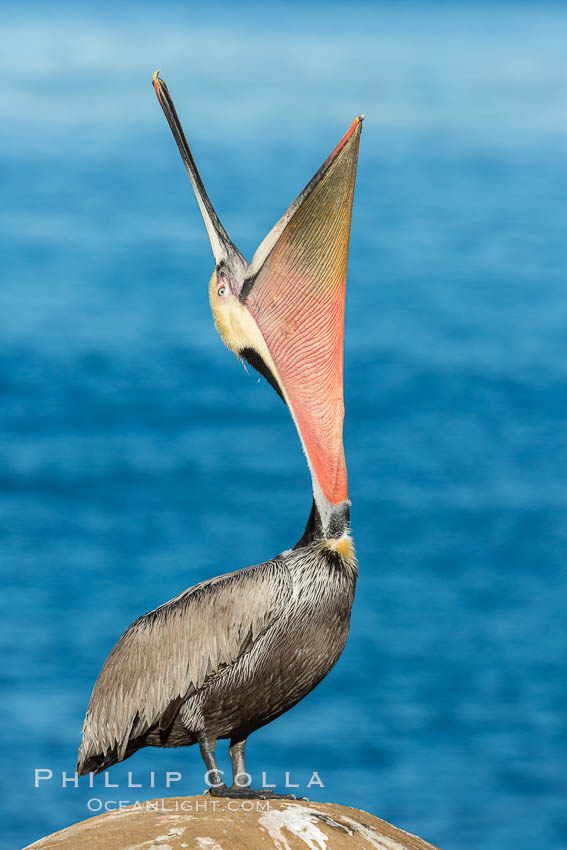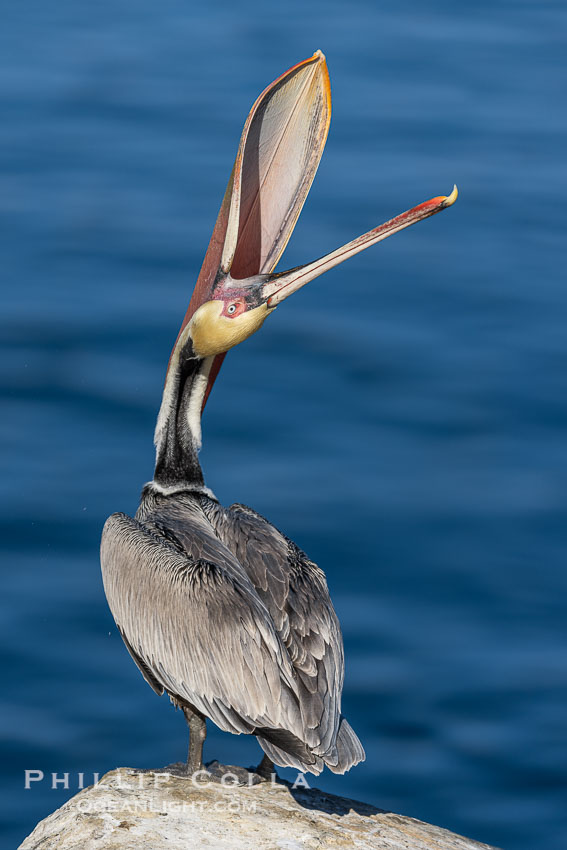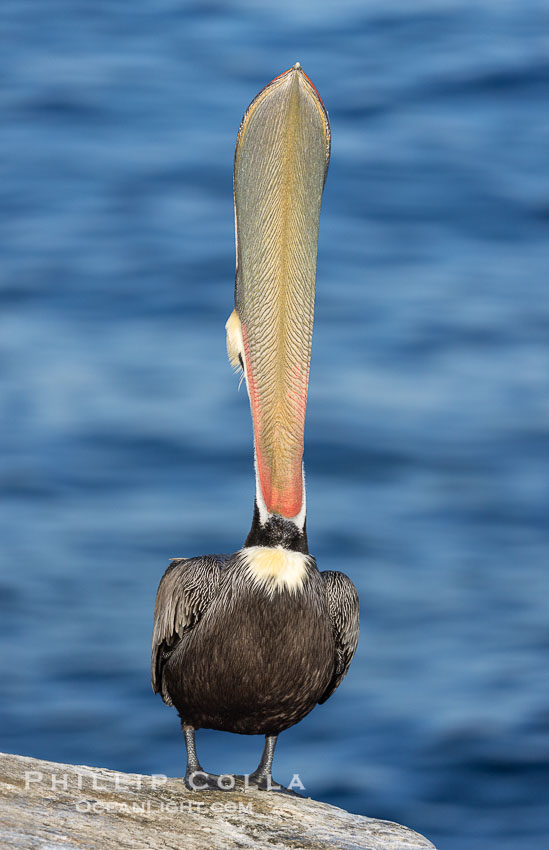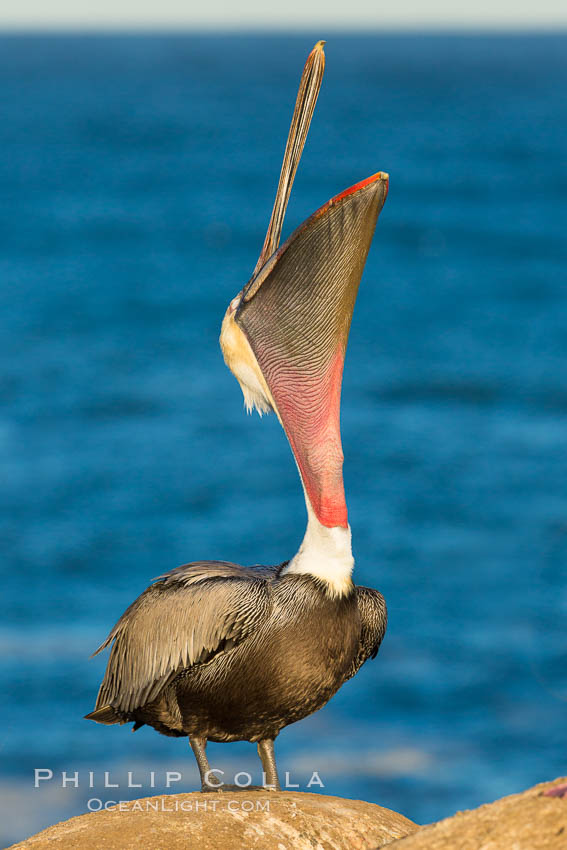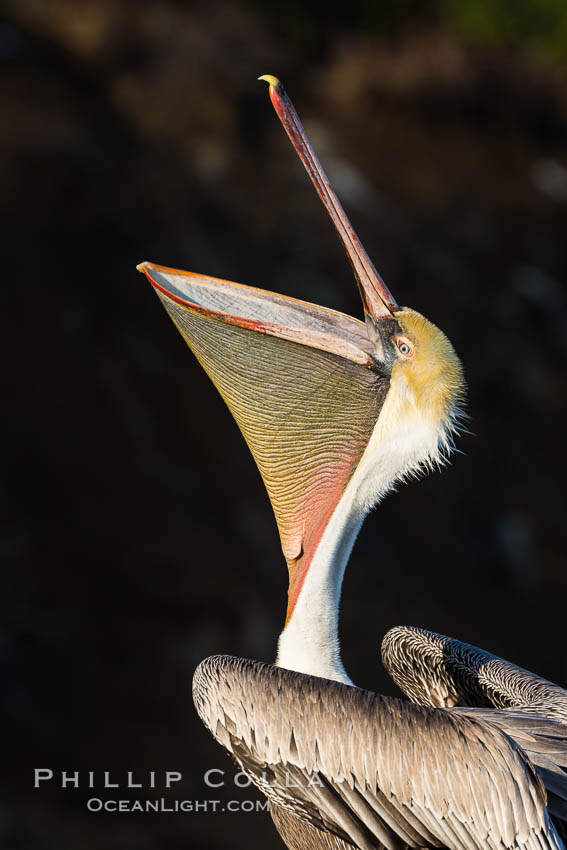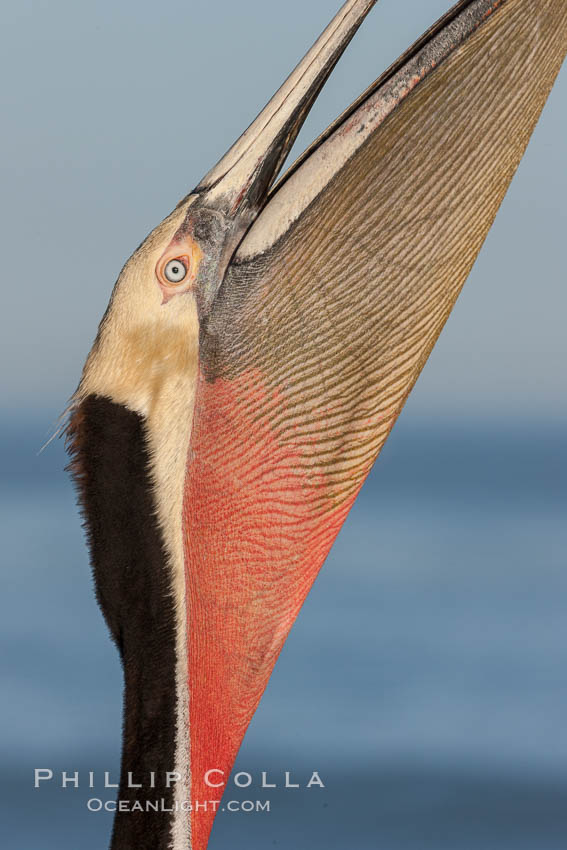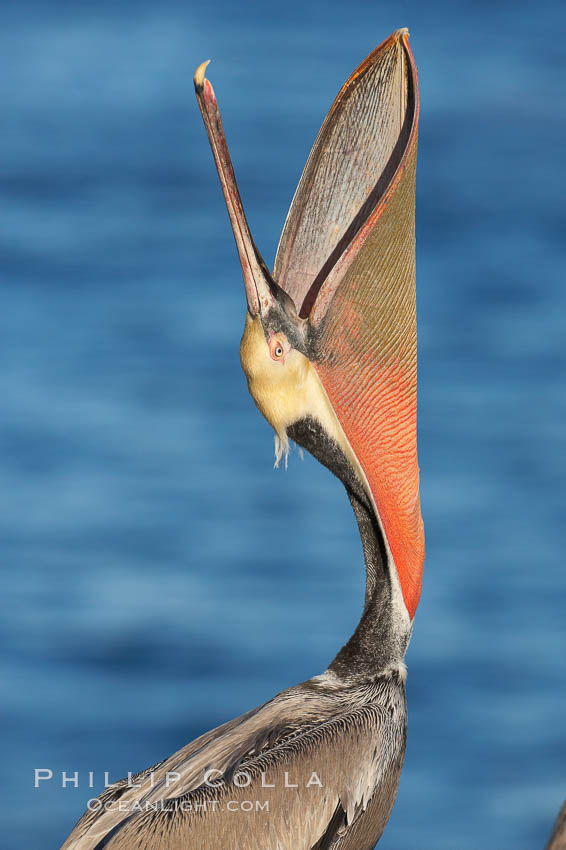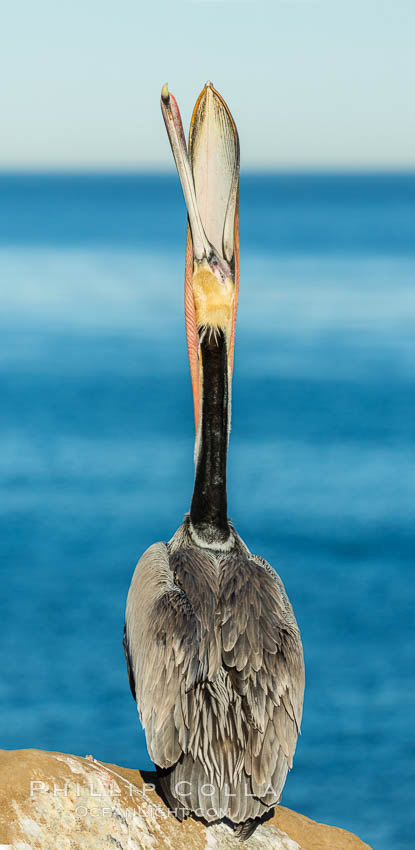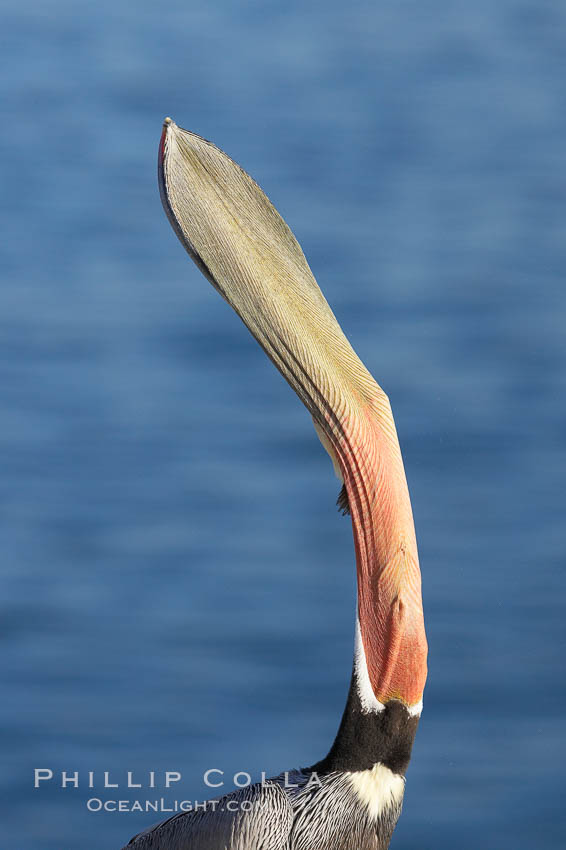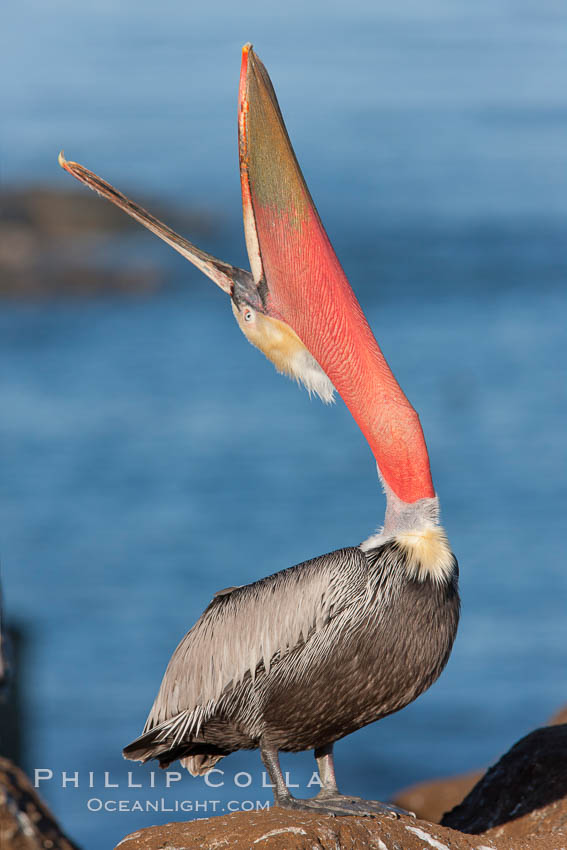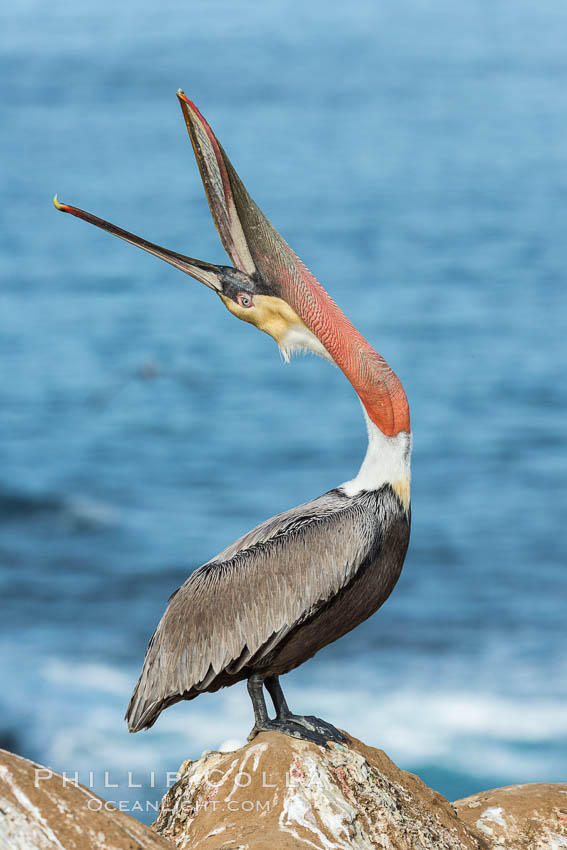I photograph brown California brown pelicans (Pelecanus occidentalis). A lot. I love them, they are at once both graceful and awkward. They surf. They dive. They eat fish. They live along the coast of California. All things I like to do too! Here are some of my favorite images, showing how beautiful these birds can be: California brown pelican photos.
California Brown Pelican head throw, stretching its throat to keep it flexible and healthy.
Image ID: 30304
Species: Brown Pelican, Pelecanus occidentalis, Pelecanus occidentalis californicus
Location: La Jolla, California, USA
There is one peculiar behavior that pelicans exhibit that is quite challenging to photograph: the “head throw“. Also known as a “bill throw”, it occurs when a pelican throws its head up and back, way way back! I have heard it said that the head throw is thought to be a way for the pelican to stretch the skin of its gular pouch — its throat — in order to maintain its flexibility and health. I think there is an aspect of group behavior to the head throw as well, sort of like a sneeze, since if one bird does it the odds are high that another nearby bird will do it just moments later. What does it mean? Who knows, I leave that to the biologists and just enjoy watching.
My ideal head throw image captures the “mouth wide open” moment, with the upper mandible an extension of the line of the neck and the lower mandible and throat pouch stretched fully, with a straight line to the bottom of the throat pouch. If the throat is that nice mix of olive green and bright red, even better, although even juveniles and in-transition adults have interesting colors to the head and throat as well. Each head thrown is like a snowflake, a little different and with its own panache. I keep shooting them even though I have thousands, looking for the elusive perfect one.
The California race of brown pelican exhibits striking mating coloration in winter, including a colorful red and green throat, yellow head and breast patch, and a bright white or deep chestnut brown hind neck. When a California brown pelican tosses its head back into a bill throw, the rich olive and red colors of its throat are really on display. This year I decided to focus my photography on a couple aspects of these birds that I had not yet photographed to my satisfaction in the past, one of which was the head throw. (The other is surf, which I will share in a few days.) I had plenty of head throw photos before, including some very nice ones, but I wanted to make some new really top notch ones, real keepers. I now have dozens of head throw sequences captured by my camera this season (thank you Canon) but only a few that I feel are really perfect, framed well with super light, rich color and sharp as a tack.
Spectacular Brown Pelican Head Throw Display. This California brown pelican is arching its head and neck way back, opening its mouth in a behavior known as a head throw or bill throw.
Image ID: 38675
Species: Brown Pelican, Pelecanus occidentalis, Pelecanus occidentalis californicus
Location: La Jolla, California
Spectacular Brown Pelican Head Throw Display. This California brown pelican extends its head and bill up and back, stretching its neck and pouch in a behavior known as a head throw or bill throw. Adult winter breeding plumage.
Image ID: 38691
Species: Brown Pelican, Pelecanus occidentalis, Pelecanus occidentalis californicus
Location: La Jolla, California
California Brown Pelican head throw, stretching its throat to keep it flexible and healthy.
Image ID: 28347
Species: Brown Pelican, Pelecanus occidentalis, Pelecanus occidentalis californicus
Location: La Jolla, California, USA
California Brown Pelican head throw, stretching its throat to keep it flexible and healthy.
Image ID: 30174
Species: Brown Pelican, Pelecanus occidentalis, Pelecanus occidentalis californicus
Location: La Jolla, California, USA
One key to photographing this behavior is to know where and when to find pelicans — that’s no secret. Another is to have ideal conditions. I live in the San Diego area so I can simply look outside to make sure the skies are clear — yielding perfect light for about an hour after sunrise — before investing the time to go shoot. Lastly, the pelicans need to be in the right mood — not bothered by people, dogs or big waves — and preening, drying and warming themselves in the sun. It is when they are relaxed and preening that they will do head throws. Once the pelican has lain down it is unlikely to do any more bill throws.
Brown pelican stretches its neck, to keep its throat pouch limber. The characteristic winter mating plumage of the California race of brown pelican is shown, with deep red gular throat, yellow head and dark brown hindneck.
Image ID: 23648
Species: Brown Pelican, Pelecanus occidentalis, Pelecanus occidentalis californicus
Location: La Jolla, California, USA
Brown pelican head throw. During a bill throw, the pelican arches its neck back, lifting its large bill upward and stretching its throat pouch.
Image ID: 18044
Species: Brown Pelican, Pelecanus occidentalis, Pelecanus occidentalis californicus
Location: La Jolla, California, USA
A challenge is anticipating when a head throw will occur, since they seem to be almost random for folks unfamiliar with pelicans. With lots of practice and 25 years spent watching this colony every winter, I’ve become fairly good at knowing when a bird is about to throw its head back, and can frame up the act and capture it reasonably well about 50% of the time. (Hey, even a blind squirrel sometimes find a nut!) It might help to think about the cat, that vile, irritable, nasty and vomit-inclined species of vermin. Cat owners usually have a sense when little precious is about to gack up a hairball or barf its last fetid, colorless meal. The creature stops licking itself, or tearing up the couch, or whatever it happens to be doing, and instead tips its head out at an odd angle, jerks its neck once or twice like something is wrong and perhaps a strange death-rattle sound eminates from its belly. Then, a few moments later – WHAM! — the cat does its thing all over your floor. It is similar with brown pelicans, only they are not so nasty. Often before one does a head throw, it will cock its head and neck at a odd angle, clap its beak once or twice, maybe even invert its throat (like sticking out its tongue) before it grows still. It may open its beak slightly as it pauses. Then, quickly, it raises its bill straight up and back, mouth open, then closing the mouth as it lowers it beak again. 2 seconds later, its over. But fortunately, a pelican that has just done a head throw is fairly likely to do it again in a few moments, so be ready to get it the second time if you miss it the first time.
California Brown Pelican head throw, stretching its throat to keep it flexible and healthy.
Image ID: 30297
Species: Brown Pelican, Pelecanus occidentalis, Pelecanus occidentalis californicus
Location: La Jolla, California, USA
Brown pelican head throw. During a bill throw, the pelican arches its neck back, lifting its large bill upward and stretching its throat pouch.
Image ID: 20284
Species: Brown Pelican, Pelecanus occidentalis, Pelecanus occidentalis californicus
Location: La Jolla, California, USA
A tip for photographers: don’t have too much lens! I like the Canon 200-400 (with built in extender) on a full frame body for all pelican photography in La Jolla these days. I see serious out-of-town bird photographers with 600 or 800mm, perhaps even on a crop body. Good luck with that. Perhaps the 800mm photographer is looking for head portraits – not that there’s anything wrong with that. But if you want full body flight and head throw shots in La Jolla, I recommend 300mm as a starting point, and sometimes will shoot a bit wider if there are lots of pelicans right up close to where I like to shoot from. With a 600 or 800, it may be hard to fit the entire bird when it is stretched out to its fullest during a head throw along with enough negative space, and there is a good chance you will clip the head or feet unless you are way way back. (I’ve even seen a few guys this year return to their cars to get a second setup because the 500mm they were using was too much for flight and head throws.) Yes, once you realize you have just clipped the feet during the head throw that you spent $4000 and travelled from the east coast to shoot, you could take several photos immediately afterward of the feet, rocks, etc and Franken-blend a composite using techniques learned in your last workshop. But natural history photographers can’t be cheaters in that way (just ask Nat Geo) and just see what happens when you submit that image to a major contest or a decent publication A rough rule of thumb I have when waiting for a head throw is to expect the composition to be about twice as tall as the bird is when it is relaxed and sitting.
California brown pelican, throwing head back to stretch its throat.
Image ID: 26287
Species: Brown Pelican, Pelecanus occidentalis, Pelecanus occidentalis californicus
Location: La Jolla, California, USA
California Brown Pelican head throw, stretching its throat to keep it flexible and healthy. Note the winter mating plumage, olive and red throat, yellow head.
Image ID: 30341
Species: Brown pelican, Pelecanus occidentalis, Pelecanus occidentalis californicus
Location: La Jolla, California, USA
If you like these, please see more California brown pelican photos or a little PDF e-guide about this choice spot. Cheers and thanks for looking!
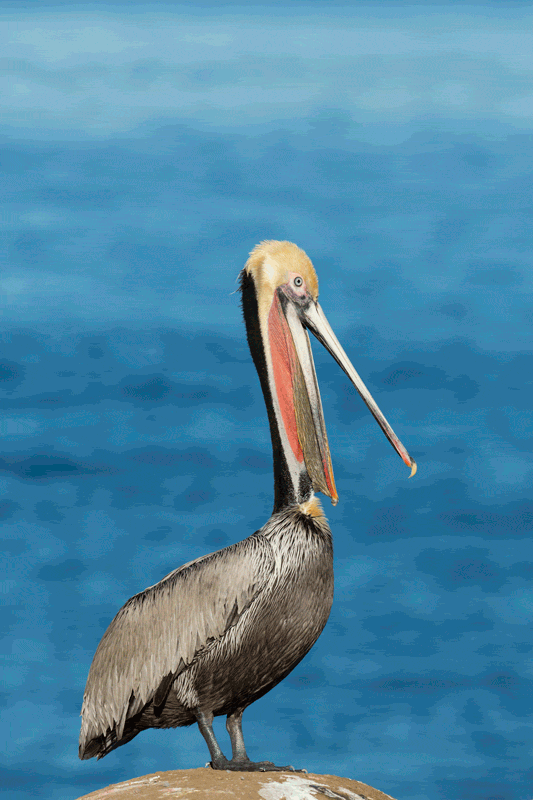

California Brown Pelican head throw, stretching its throat to keep it flexible and healthy.
Image ID: 30287
Species: Brown pelican, Pelecanus occidentalis, Pelecanus occidentalis californicus
Location: La Jolla, California, USA
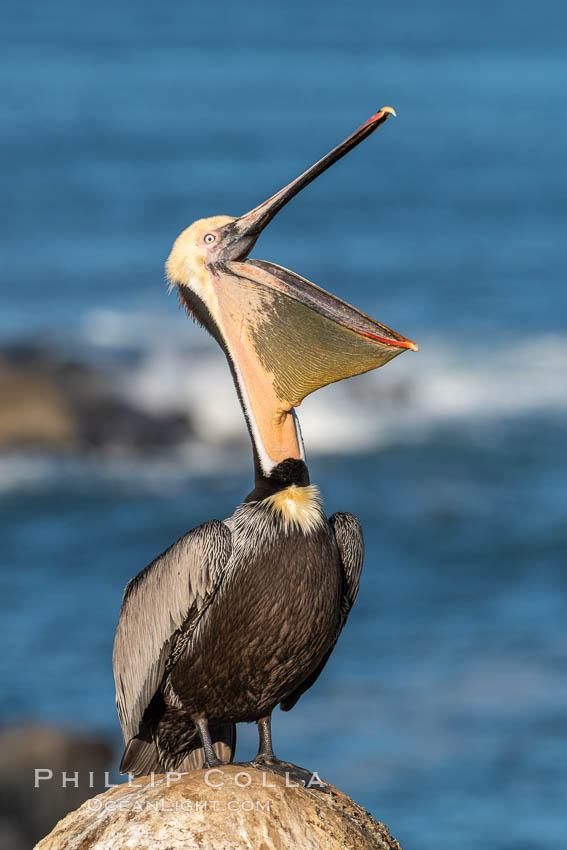
California Brown Pelican head throw, stretching its throat to keep it flexible and healthy.
Image ID: 36692
Species: Brown pelican, Pelecanus occidentalis, Pelecanus occidentalis californicus
Location: La Jolla, California, USA
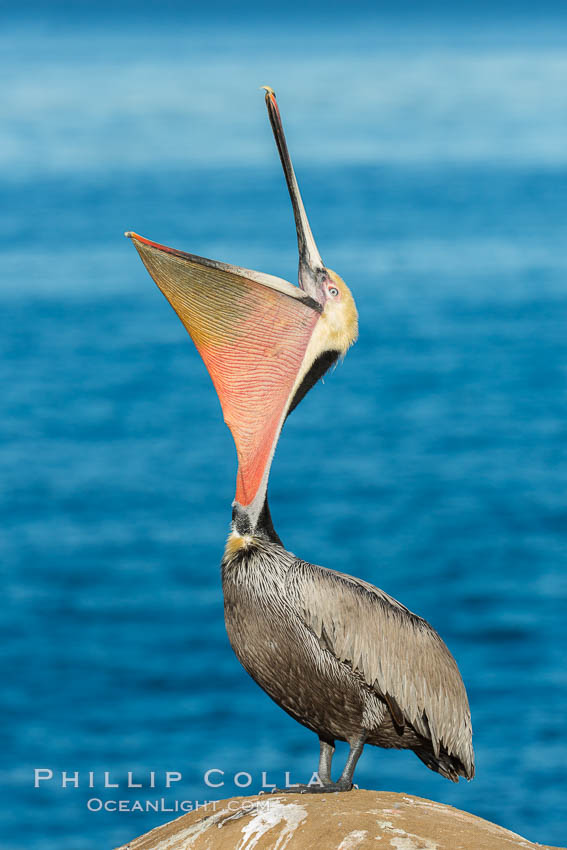
California Brown Pelican head throw, stretching its throat to keep it flexible and healthy.
Image ID: 30302
Species: Brown pelican, Pelecanus occidentalis, Pelecanus occidentalis californicus
Location: La Jolla, California, USA
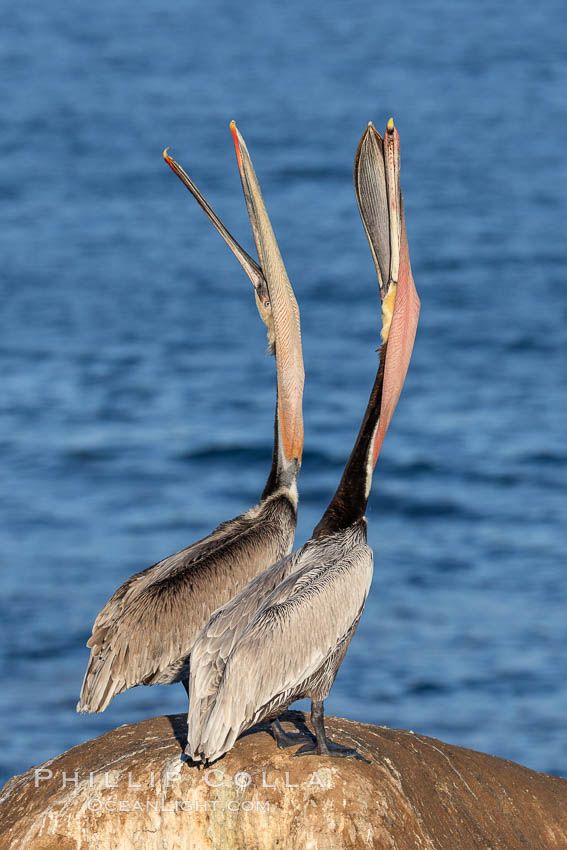
Two California Brown Pelicans performing a perfectly synchronous simultaneous head throw. Both display classic winter breeding plumage. Set against the Pacific Ocean.
Image ID: 37564
Species: Brown Pelican, Pelecanus occidentalis, Pelecanus occidentalis californicus
Location: La Jolla, California, USA
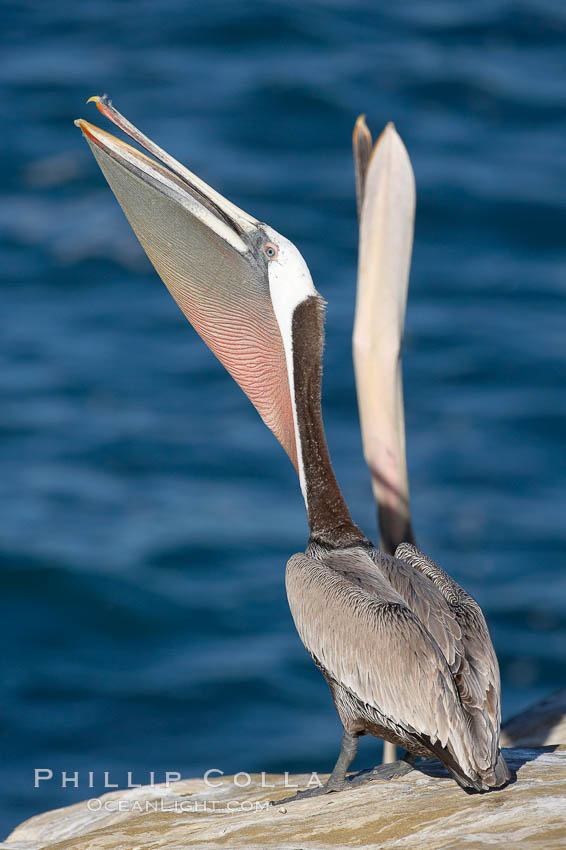
Two California brown pelicans stretch their throats with simultaneous head throws. California race with winter mating plumage.
Image ID: 18434
Species: Brown pelican, Pelecanus occidentalis, Pelecanus occidentalis californicus
Location: La Jolla, California, USA
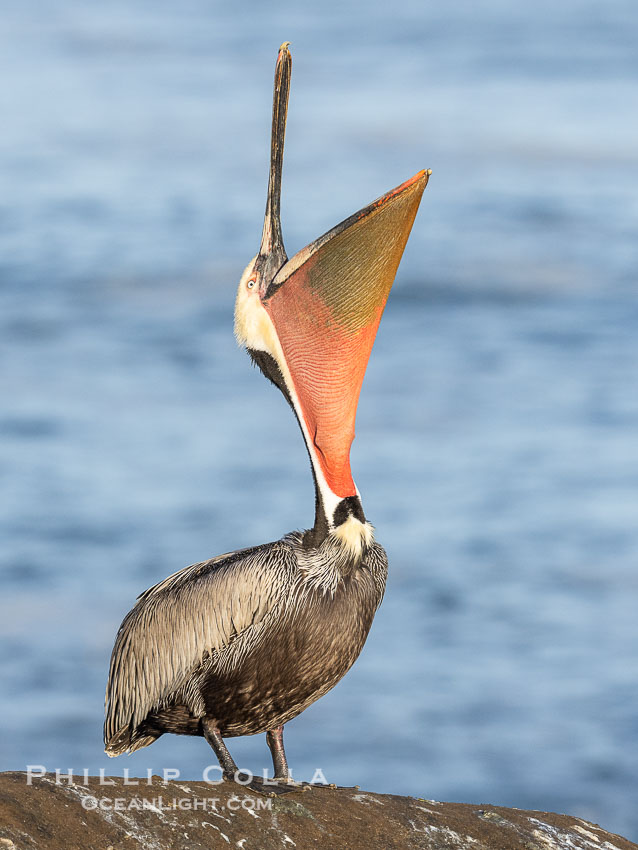
A perfect Brown Pelican Head Throw with Distant Ocean in Background, bending over backwards, stretching its neck and gular pouch, winter adult breeding plumage coloration.
Image ID: 38888
Species: Brown Pelican, Pelecanus occidentalis, Pelecanus occidentalis californicus
Location: La Jolla, California
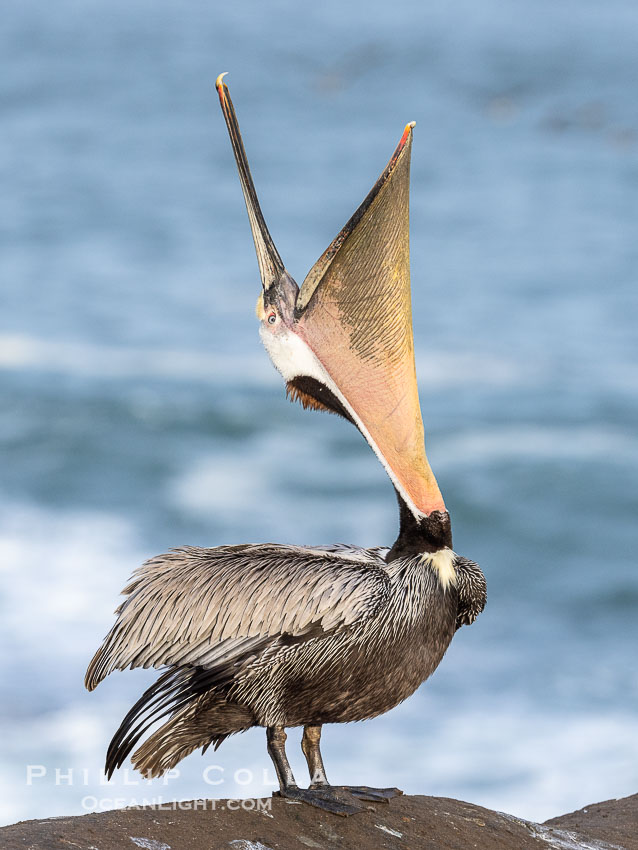
A perfect Brown Pelican Head Throw with Distant Ocean in Background, bending over backwards, stretching its neck and gular pouch, winter adult breeding plumage coloration.
Image ID: 38879
Species: Brown Pelican, Pelecanus occidentalis, Pelecanus occidentalis californicus
Location: La Jolla, California
The glottis exposure of the brown pelican, during which the pelican will essentially partially invert its throat pouch (and sometimes eject a bit of something) often immediately precedes or follows a head throw. If you see the brown pelican cock its head strangely, or act as if it is about the “burp” or has a “kink in its neck” — any of those actions — get ready, since a head throw may soon follow. Also, it is not unheard of for a bird to do two head throws back-to-back. (I use the word “burp” loosely and anthropomorphically.) So be ready…
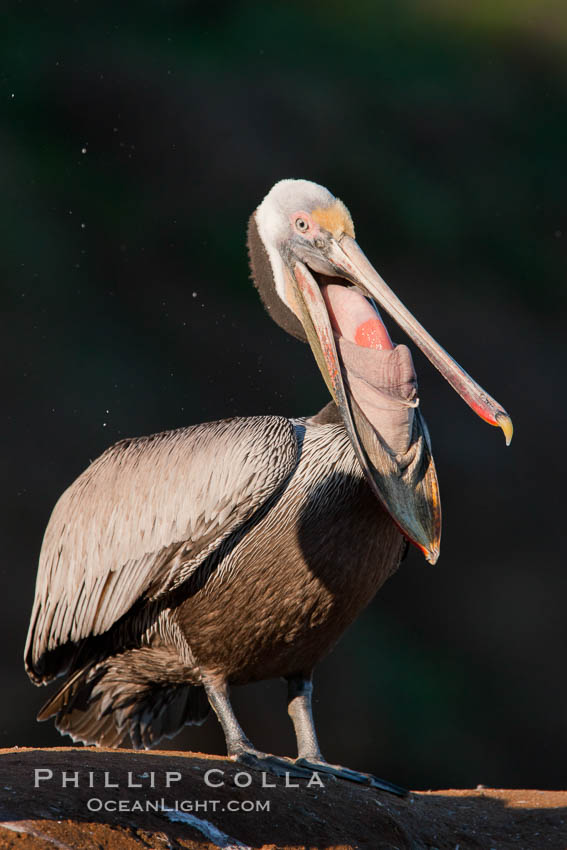
California brown pelican.
Image ID: 26289
Species: Brown pelican, Pelecanus occidentalis, Pelecanus occidentalis californicus
Location: La Jolla, California, USA
